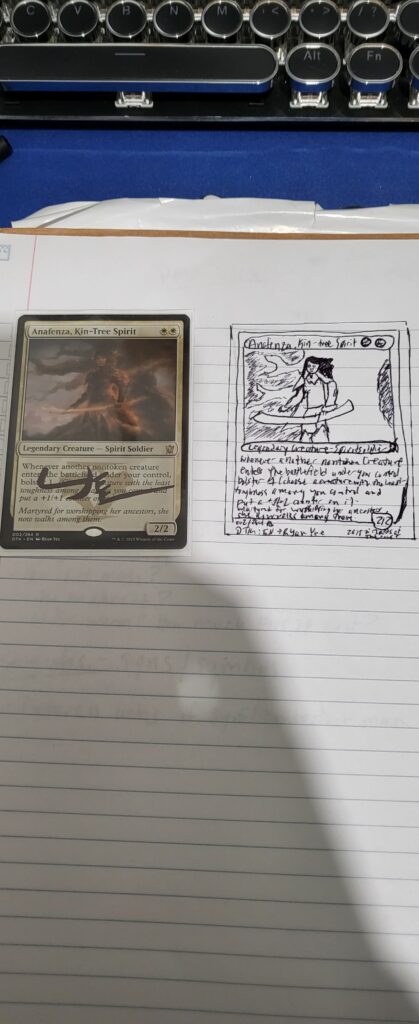This week one of our readings was, ‘’Thick Description: Toward an Interpretive Theory of Culture’’ by Clifford Geertz. He borrows ‘’thick description’’ from Gilbert Ryle, and believes the same as Max Weber that man is an animal who is suspended in webs of significance. He interprets culture to be those webs. Even though this reading is short, it is dense and difficult to grapple with. My interpretation and application of this to material culture would be that through ‘’thick description’’ we can offer cultural context and meaning to an artifact. The final paragraph suggests that we shouldn’t be trying to answer the deepest question, but instead provide answers to those outside of the community. I am unable to answer everything about my object, but I can provide enough information that can help others to better understand my object and the web of culture around it.b
Magic: The Gathering is a card game that first hit the market in 1993. The game is celebrating its 30th anniversary this year, and the city of Philadelphia will be hosting a massive convention and the Pro Tour in two weeks. I’ll be in attendance and hope to share photos from the event. Magic as a game has changed my life. My brother has always been my best friend, but the game brought us even closer and I’ve always looked up to him as a person, and as a player. I also have made so many friends in the community and it has also shaped my outlook on the world and life. This is the reason I choose to examine Magic: The Gathering cards as my object for material culture.
The cards in the game have changed over the years in appearance. I’ll be focusing on the new framing and creation of cards. Magic: The Gathering cards are 2.5 x 3.5 inches with a weight of 1.814 grams. Oversized cards are printed as promotional products, but I don’t have any of these to measure. Magic cards are made of two layers of cardboard joined together by an opaque blue adhesive with a core between the two layers (mtg.fandom). The card stock gives the card bounce and flexibility. In fact, one of the ways to check if a Magic card is fake or re-backed (the process of putting the face of a card onto a newer back of a card to appear newer) is to bend the card. If the card snaps or the art rips, the card is a forgery. If the card bends back to shape, it’s real! You can also use a jeweler’s diamond to look at the rosettes inside the core. Magic cards are printed on a card stock called Corona, which is sourced from three factories. These are Arjowiggins in France, Kohler in Germany, and USPC in the USA (mtg.fandom). There was an article published by Wizards of the Coast, the company that produces the game, entitled ‘’Improvements in Upcoming Cardstock’’ on June 5, 2019. Unfortunately, the article has been removed from the website, and the link doesn’t work anymore.
In 1992, Richard Garfield and Peter Adkinson approached Cartamundi, a game manufacturer, and started their partnership. Magic cards have been printed with Cartamundi for 30 years. Engineers from Turnhout, Belgium, created a custom printing machine to accommodate the job. Cartamundi is an international company with six locations in America, One in Japan, One in Mumbai, One in Singapore, and Sixteen locations in Europe. I’ve reached out to Cartmundi with questions on pricing and I’m currently waiting to hear back.
Wizards of the Coast, the owners of Magic: the Gathering has recently made a change to the languages the game is printed in. The core eight languages they are focusing on for products are English, Japanese, Chinese (simplified), French, Italian, German, Spanish, and Portuguese. The languages that were discontinued starting September 9th of 2022 are Russian, Korean, and Chinese (traditional).
A noticeable difference in modern Magic: the Gathering cards is the way the edges look. Laser cutting helps speed up the process of printing and creates a more unified edge look. Specialists from TCGPlayer noticed the changes in the edges of cards printed around September 2021 and forward. I’ll include a picture and a link to the article that demonstrates the differences in edges from laser cuts.
